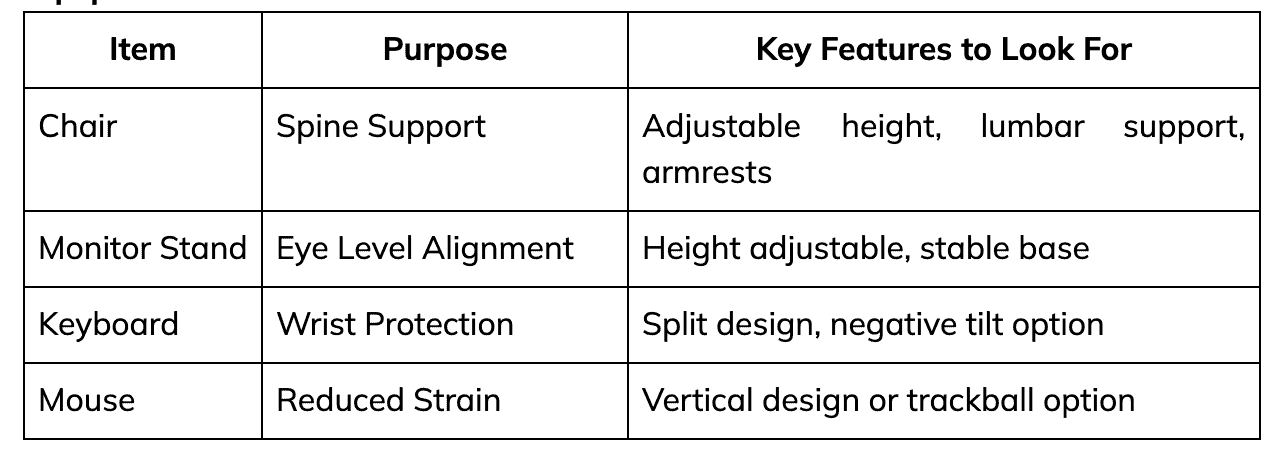Blogs
The Role of Ergonomics in Reducing Back and Neck Pain

The role of ergonomics in reducing back and neck pain is significant, as poor posture and improper workstation setups are common culprits. Adjusting your chair to support your lower back, positioning your computer screen at eye level, and keeping your feet flat on the floor can alleviate unnecessary strain on your spine and neck. Ergonomic tools like adjustable desks and supportive cushions also help maintain proper alignment. Regular movement and stretches throughout the day are equally important.
With simple ergonomic adjustments, you can prevent pain, enhance comfort, and support your overall spinal health in the long term.
Understanding the Pain-Posture Connection
As a spine specialist, I’ve seen countless patients whose back and neck pain stems from poor posture and workplace ergonomics. Let’s explain why this happens: imagine your spine as a flexible tower of blocks. When perfectly stacked, it’s stable and strong. But lean those blocks forward (like when you’re hunching over your computer), and the structure becomes strained.
According to the International Ergonomics Association, work-related musculoskeletal disorders are among the most common office injuries. The good news? Most of these issues can be prevented with proper ergonomic interventions.
What Exactly is Ergonomics?
Consider ergonomics as the science of making your workspace work for you, not against you. It’s about creating an environment that supports your body’s natural alignment while reducing strain on your muscles, ligaments, and joints.
Creating Your Pain-Free Workspace
The Foundation: Your Chair
Your office chair isn’t just a place to sit – it’s your spine’s best friend (or worst enemy). Here’s what to look for:
- Height adjustment: Your feet should rest flat on the floor
- Lumbar support: Think of it as a gentle hand supporting your lower back
- Armrests: Should let your shoulders relax naturally
- Seat depth: Leave about two fingers’ width between the back of your knees and the chair
Pro tip: If your chair feels like a torture device by day’s end, it’s time to upgrade!
Monitor Magic
Position your screen where your neck will thank you:
- Arm’s length away (20-30 inches)
- Top of the screen at or slightly below eye level
- Directly in front to avoid the “tech neck” twist
Keyboard and Mouse Positioning
Let’s talk about your typing tools. Here’s the ideal setup:
- Keyboard centered in front of you
- Elbows at a relaxed 90-degree angle
- Wrists floating like they’re on a gentle wave (not crashed on the desk)
- Mouse close by – no reaching like you’re trying to grab something off a high shelf!
Movement: Your Secret Weapon
As a doctor, I can’t stress this enough: the best posture is your next posture! Even perfect ergonomics can’t beat the benefits of movement. Try these:
The 20-20-20 Rule
Every 20 minutes:
- Take 20 seconds
- Look 20 feet away
- Do a quick stretch
Keyboard and Mouse Positioning
- Shoulder rolls (like you’re shrugging off stress)
- Gentle neck rotations (imagine you’re saying “no” to bad posture)
- Wrist flexes (wave hello to better ergonomics)
Common Workplace Scenarios
The Home Office Hero
Working from home? Transform your dining table into an ergonomic workspace:
- Use cushions for lumbar support
- Raise your laptop with books (just not your favorite novels!)
- Consider a separate keyboard and mouse
The Multi-Monitor Maven
Using multiple screens? Arrange them like a gentle curve around you, keeping your neck rotation minimal. Think of it as creating your command center!
The Standing Desk Superstar
Standing desks are great, but remember:
- Alternate between sitting and standing
- Start with short-standing periods
- Keep your knees slightly bent
- Use an anti-fatigue mat (your feet deserve comfort too!)
When to Seek Help
As someone who’s treated thousands of patients with neck and back pain, I always say: if your body is sending you smoke signals, don’t wait for the fire! Contact a healthcare professional if you experience:
- Persistent pain lasting more than two weeks
- Pain that radiates down your arms or legs
- Numbness or tingling
- Headaches that worsen throughout the workday
Expert Tips from Years in Practice
From my experience in treating work-related musculoskeletal disorders:
- Invest in prevention: Good ergonomic equipment costs less than medical bills
- Listen to your body: Pain is your body’s check engine light
- Move frequently: Even perfect posture becomes problematic if held too long
- Stay hydrated: Your spinal discs need water to stay healthy
Special Considerations for Medical Students
For my future colleagues hitting the books:
- Create multiple study stations to encourage movement
- Use a document holder for those heavy textbooks
- Take regular breaks (your brain will thank you too!)
- Consider a tablet stand for digital textbooks
Professional Assessment
Sometimes, you need an expert eye. A physical therapist or ergonomist can:
- Evaluate your workspace setup
- Identify risk factors
- Provide personalized recommendations
- Teach proper stretching techniques
The Scoliosis Center of Utah specializes in comprehensive ergonomic assessments and work-related back and neck pain treatments. Our team understands the unique challenges of modern workspaces and can help you create an environment that supports your spinal health.
Equipment Recommendations

All recommendations are based on systematic reviews and meta-analyses of ergonomic interventions in office settings.
For personalized guidance on creating an ergonomic workspace that suits your unique needs, visit us at the Scoliosis Center of Utah. Your spine health is our priority!

Dr. Katalina Dean
Dr. Katalina Dean is the founder and clinical director of Scoliosis Center of Utah, in Midvale, UT. Her team specializes in posture correction, spinal rehabilitation, and non-invasive scoliosis care and bracing.
Call Today
Do You Qualify for Care?
Schedule an Appointment Below
